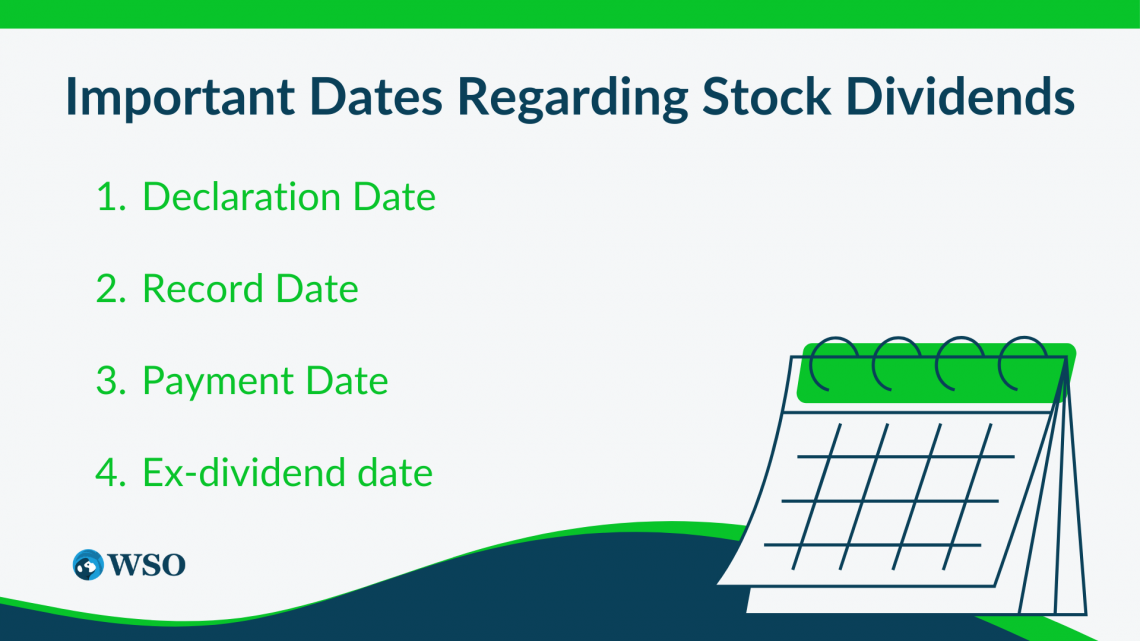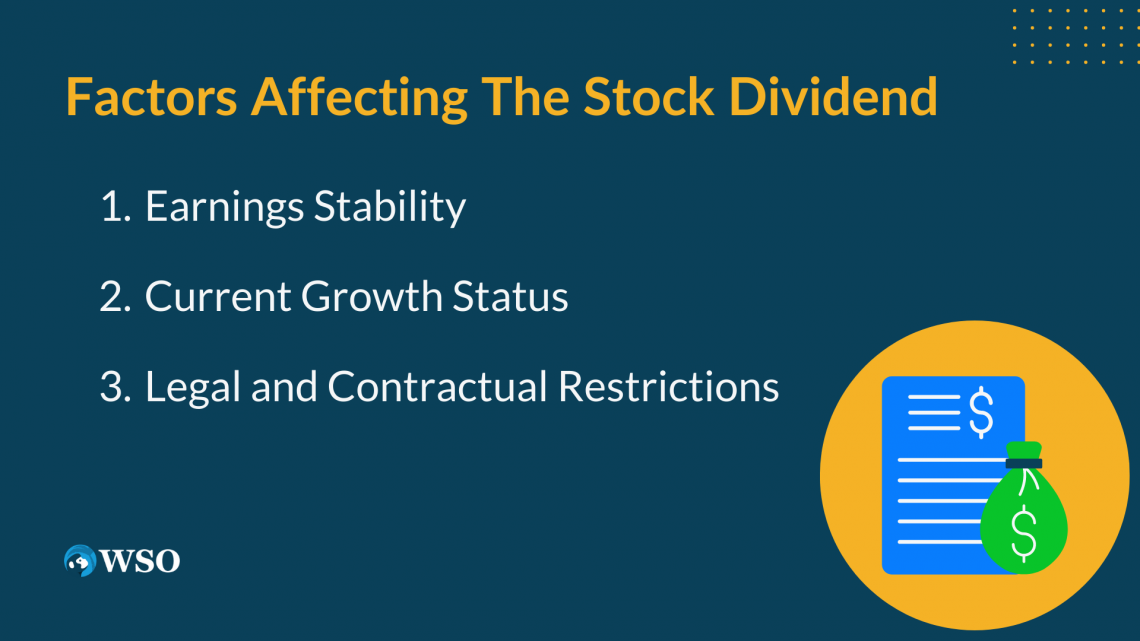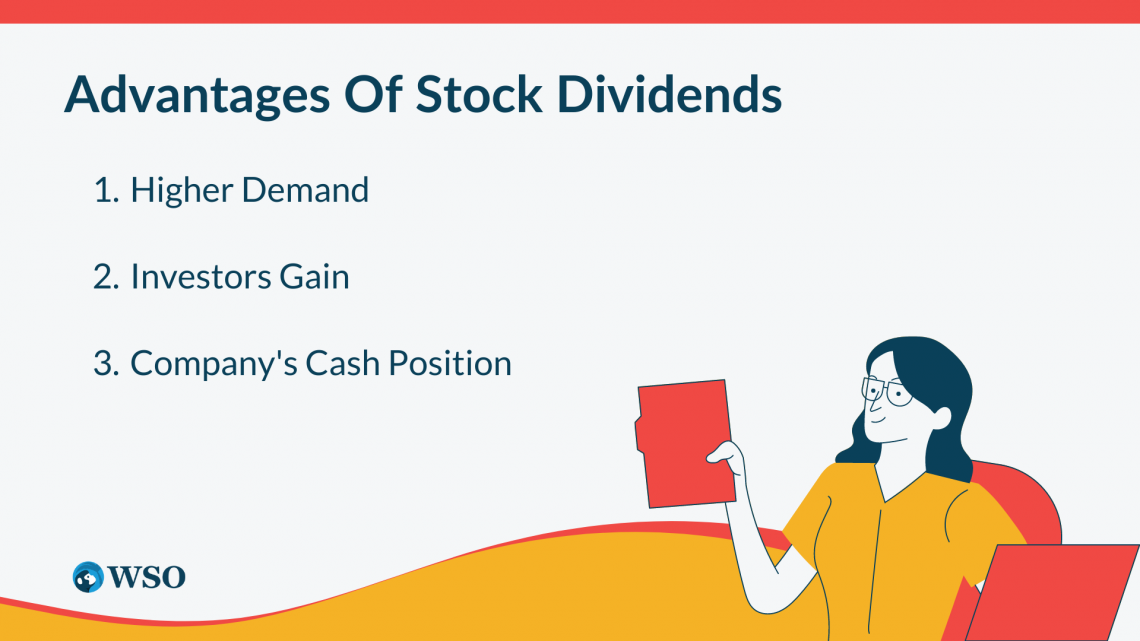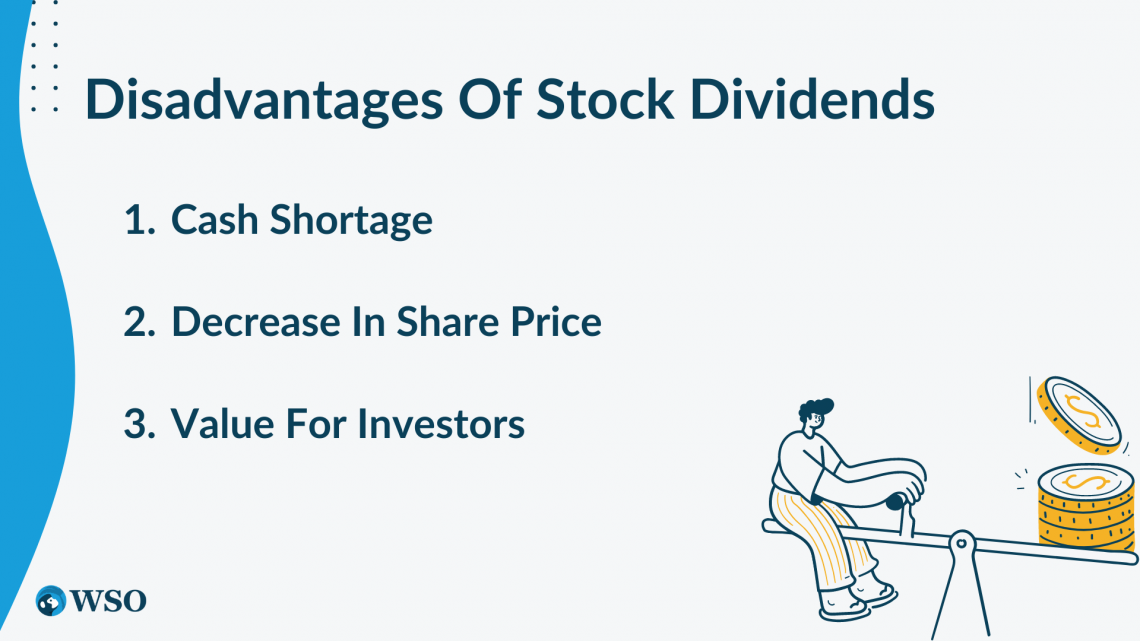Stock Dividend
A Distribution of additional shares to existing shareholders as a form of dividend payment.
Stock dividends are monetary rewards that shareholders (individuals who own a piece, or “share”, of the company) receive.

An investor's return on a stock is determined by the capital gains and dividends received.
Capital gain is the return on investment resulting from the difference between the buying and selling price of the stock. The buyer benefits when the stock price increases, whereas the seller benefits from a decreased price. Shareholders receive dividends from a portion of the company's earnings.
When a company distributes dividends, more investors are attracted to the business. Similarly, the existing shareholders are rewarded for retaining the shares. Dividends also signal that a company has consistent growth and its earnings forecasts are stable.
Dividends are received only by investors who hold an interest in the company in the form of shares. Generally, such investors reinvest their dividends back into the company to compound their future earnings.
As dividends are paid from earnings, the possibility of investing in other ventures is limited for the company. In spite of this, the advantages of paying their shareholders outweigh the disadvantages.
Dividends come in many forms, not limited to:
- Cash
- Stock
- Scrip (an option given to the shareholders to redeem a future dividend or additional stock)
- Property.
In this article, however, stock dividends shall be our primary topic of discussion.
Key Takeaways
- A stock dividend is the additional shares issued to the shareholders as a dividend payout.
- The issuance of SDs has a dilutive effect on the company's equities.
- Factors including earnings stability, current growth status, and legal and contractual restrictions are considered before issuing an SD.
- Stock dividends are paid from the retained earnings transferred to the paid-in capital account.
- A company can benefit from increased demand and cash position by issuing an SD. The investors can gain when they sell the additional shares and maintain the same number of shares they had.
- When companies issue an SD, it could indicate cash shortage issues. Furthermore, there is no value created for the shareholders.
What Is A Stock Dividend?
SDs are additional shares issued to shareholders. It is a form of dividend payout (in the form of stock in lieu of cash).

In most cases, it is a small percentage ranging from 1% to 10%. However, companies may issue a higher fraction. When the ratio is above 25%, it is termed a high dividend payout.
Consider a scenario in which a company announces issuing a 10% stock dividend. For an investor holding 5,000 shares, it would mean that they would receive additional 500 (5,000 * 10%) shares. The total shares the investor would own after the dividend would be 5,500.
The calculation is as follows:
- Investor Owns: 5,000 shares
- Company Stock Dividend Issuance: 10%
New shares allocated to the investor = 5,000 * 10% = 500
Total shares owned by the investor after stock dividend payout: 5,500
SDs are issued by companies when they need cash to manage their businesses and cannot allocate any cash dividends to their investors. It is another form of shareholder payout without the use of cash.
SDs increase the paid-in capital with a decrease in retained earnings. It does not increase the company's market value as share prices decrease to accommodate the newly issued shares.
At times, investors may be required to comply with a "holding period" for the shares they have newly received. The holding period is the duration during which the stock should not be sold.
Cash dividends are taxed as the investor receives them. In contrast, a SD is taxed only when the shares have been sold. A capital gains tax is levied on the profit generated from the sale.

On the other hand, companies that issue a higher fraction of stock dividends generally have a slower growth rate. It can also indicate that the company is proportioning, or taking too much out of their retained earnings for their investors.
Growing companies require their funds to be intact to invest in more opportunities. Some well-known fast-growth companies like Tesla and Amazon have never issued dividends to their shareholders.
Dilutive Nature of Stock Dividends
The issuance of a stock dividend has a dilutive effect on the company's equities. Dilution is the reduction in shareholders' equity because of an issue of additional shares. Let us understand this better with the previous example.

Let us assume that a company has $1 million outstanding shares with a market capitalization of $10 million. Each stock is worth $10 ($ 10,000,000 market cap. / $1,000,000 shares).
When the company issued 10% more shares, the total shares issued increased to $1.1 million. The market capitalization, however, remains unchanged. So, the share price decreases to $9.091 ($10,000,000 market cap./ $1,100,000 shares).
Similarly, the number of shares an investor holds would increase. The investor would be pleased to receive more shares than they previously held. However, since the share price decreases, the stock dividend dilutes their holdings.
Suppose an investor purchased 1,000 shares at $10 when the company announced a stock dividend. The investor holds stocks worth $10,000.
The investor eventually receives 100 bonus shares, bringing their total quantity to 1,100 shares. Since the bonus shares dilute the price to $9.091, the value of the investor's holding remains at $10,000 (1,100 * 9.091).
Important Dates Regarding Stock Dividends
The four crucial dividend dates are listed below.

1. Declaration Date
It is the date the company's directors formally approve the fraction of the SD through a vote. Together they stipulate the recording and payment date. The dividend becomes a liability on this day.
2. Record Date
It is the date at which the company's existing shareholders are determined. The company sets it, and only the investors that own the stock on the record date would be eligible to receive the dividend.
3. Payment Date
It is the date at which the shareholder would receive shares as a stock dividend. In the case of cash dividends, it is the date at which investors receive the funds from the company.
4. Ex-dividend date
The stock exchanges decide on this date, usually the day after payment. It is the day the stock price adjusts to the new shares that will be issued.
Based on our previous example, the ex-dividend date is when the stock would start trading at $9.09, a reduction from $10. The ex-dividend date falls before the record and payment date for cash dividends.
Factors Affecting The Stock Dividend
The decision to payout dividends to shareholders lies on the company's management.

Some companies do not issue any additional income to their shareholders. The management believes that the gains from a change in share price with high upward potential and exponential growth provide adequate compensation.
At the same time, other companies maintain a constant dividend yield and increase it annually. These companies are included in the S&P Dividend Aristocrats indices. It contains a couple of indices, the most popular being the S&P 500 Dividend Aristocrats.
For companies that issue this compensatory tool, the following factors are considered.
1. Earnings Stability
Companies prefer maintaining a minimum dividend payout rate regardless of their current earnings. When earnings fluctuate, the minimum dividend policy acts like an earnings stabilizer for shareholders.
Alternatively, some companies prefer to declare their dividends based on their earnings. When the profits are high and stabilized, a higher dividend is announced, and vice-versa.
2. Current Growth Status
Companies facing a high growth rate during the year would require funds to be in the business. Thus, they would have small dividend payouts. Managers justify this action as they believe that shareholders’ benefit from capital gains outweighs the dividend income.
3. Legal and Contractual Restrictions
As per accounting guidelines, a company should only pay dividends from retained earnings, not paid-in capital.
Additionally, a company could be limited by debt covenants if they have undertaken a significant amount of debt. Some debt covenants restrict the company from paying dividends above a certain payout ratio.
How To Account for Stock Dividends?
Recall that a stock dividend is dilutive. Yet, the market capitalization or the company's equity value remains unchanged. There are more shares issued, which decreases the share price. The value of the shares also remains the same for the investor.

The new shares are created by using up the retained earnings. That amount is transferred to the paid-in capital. Let us understand the journal entry for this transaction with an example.
A company issues a stock dividend of 10% when its outstanding shares are 100,000. The stock's market price is $20, and its face value is $15.
When the SD is issued, the total number of shares rises by 10,000 (100,000 * 10%). The new shares are valued at $200,000 ($20 * 10,000). This amount is deducted and debited from the retained earnings account.
The shares outstanding account is impacted by the face value of the new shares, i.e., $150,000 ($15 * 10,000). The balance is credited from the paid-in capital account.
| Particulars | Debit | Credit |
|---|---|---|
| Retained Earnings A/C | 200,000 | |
| To Shares Outstanding A/C | 150,000 | |
| To Paid-in Capital A/C | 50,000 |
This journal entry must be passed when the new shares issued are below 25% of the outstanding shares. The journal entry slightly differs when the percentage is above 25%. We use face value only instead of valuing the shares at the market price.
If we alter the fraction of the stock dividend to 40%, the new number of shares is 40,000 (100,000 * 40%). The new shares would be valued at the issue price, i.e., $600,000 ($15 * 40,000).
| Particulars | Debit | Credit |
|---|---|---|
| Retained Earnings A/C | 600,000 | |
| To Shares Outstanding A/C | 600,000 |
Advantages and Disadvantages Of Stock Dividends
Dividends are a sign that the company has been performing well and has the ability to reward its shareholders for holding the stock. Let's take a deeper dive to understand the advantages.

1. Higher Demand
When the stock price decreases and passes the ex-dividend date, the share price decreases to adjust to the newly issued shares.
As the price falls, the stock becomes affordable, and more investors would want to purchase the stock. Thus, a higher demand is created, eventually raising its price.
Potential investors also form a better opinion of a company that regularly issues dividends. Additionally, when more shares are outstanding in the market, more shareholders will purchase and trade with the shares.
2. Investors Gain
Although investors don't seem to gain any benefit from receiving additional shares, they can trade with the new shares for capital gains. Investors should also pay taxes only when they sell the shares rather than a receipt.
For example, an investor receives 100 new shares as dividends for holding 1,000 shares. The investor can eventually sell the new shares only and still maintain the same number of shares they had before.
3. Company's Cash Position
Since the company can issue shares out of retained earnings without affecting the cash reserves, they prefer to indulge in it. The cash amount is unaffected and can be used for other growth opportunities.
It can also indicate that the company may have a cash shortage — the disadvantages, although few, are listed below.

1. Cash Shortage
It may also be possible that the company cannot meet its obligations with the present cash reserves. In such a case, a corporation cannot issue cash dividends, bringing a negative sentiment.
It indicates financial instability and can drive the price downwards.
2. Decrease In Share Price
A slight decrease in the share price could be chaotic in the market. Share prices would fall even further if the additional shares were numerous (>25%). It may cause a negative market sentiment.
3. Value For Investors
Bonus shares do not carry any value to the investor. Even though investors receive more shares, the value is unchanged as the share price is adjusted.
Stock Dividend FAQ

Companies announce the possibility of paying a dividend in their published audited financial statements. It is usually mentioned with a disclaimer for the directors' approval and the date when the directors' meeting will commence.
Another way to find this information is through stock research websites. Popular websites include The Motley Fool, Yahoo! Finance, MorningStar, and Bloomberg.com.
Companies can pay dividends annually and during the interim (part of the financial year - March, June, September and December). Dividends announced at the end of the financial year are final, while interim dividends are announced during the year. Interim dividends are stated in the quarterly financial statements.
Companies issue stock dividends when they do not want to reduce their cash. The cash reserves are mostly used to invest in risky projects that could generate growth.
Yes, they are taxed only when an investor sells the shares.
Tools like the dividend yield, Dividend Per Share (DPS), and Dividend Payout Ratio (DPR). These tools indicate the level of dividend payouts and create a common base for comparison.
For all these tools, a resultant higher value is most desirable.




or Want to Sign up with your social account?